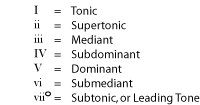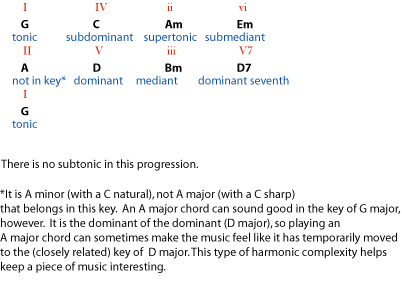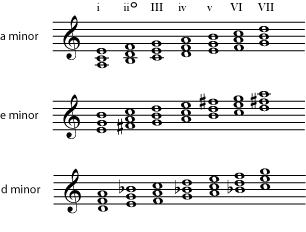| << Chapter < Page | Chapter >> Page > |
Extensive study and practice are needed to be able to identify and understand these more complex progressions. It is not uncommon to find college-level music theory courses that are largely devoted to harmonic analysis and its relationship to musical forms. This course will go no further than to encourage you to develop a basic understanding of what harmonic analysis is about.
So far we have concentrated on identifying chord relationships by number, because this system is commonly used by musicians to talk about every kind of music from classical to jazz to blues. There is another set of names that is commonly used, particularly in classical music, to talk about harmonic relationships. Because numbers are used in music to identify everything from beats to intervals to harmonics to what fingering to use, this naming system is sometimes less confusing.

The following chord progression is in the key of G major. Identify the relationship of each chord to the key by both name and number. Which chord is not in the key? Which chord in the key has been left out of the progression?


Since minor scales follow a different pattern of intervals than major scales, they will produce chord progressions with important differences from major key chord progressions.
Write (triad) chords that occur in the keys of A minor, E minor, and D minor. Remember to begin each triad on a note of the natural minor scale and to include only notes in the scale in each chord. Which chord relationships are major? Which minor? Which diminished? If you need staff paper, print this PDF file
The tonic, subdominant, and dominant are minor (i, iv, and v). The mediant, submediant, and subtonic are major (III, VI, and VII). The supertonic (ii) is diminished.

Notice that the actual chords created using the major scale and its relative minor scale are the same. For example, compare the chords in A minor ( [link] ) to the chords in C major ( [link] ). The difference is in how the chords are used. As explained above , if the key is C major, the chord progression will likely make it clear that C is the tonal center of the piece, for example by featuring the bright-sounding (major) tonic, dominant, and subdominant chords (C major, G major or G7, and F major), particularly in strong cadences that end on a C chord.
If the piece is in A minor, on the other hand, it will be more likely to feature (particularly in cadences) the tonic, dominant, and subdominant of A minor (the A minor, D minor, and E minor chords). These chords are also available in the key of C major, of course, but they typically are not given such a prominent place.
As mentioned above , the "flavor" of sound that is created by a major chord with a minor seventh added, gives a particularly dominant (wanting-to-go-to-the-home-chord) sound, which in turn gives a more strong feeling of tonality to a piece of music. Because of this, many minor pieces change the dominant chord so that it is a dominant seventh (a major chord with a minor seventh), even though that requires using a note that is not in the key.

Notification Switch
Would you like to follow the 'Introduction to music theory' conversation and receive update notifications?